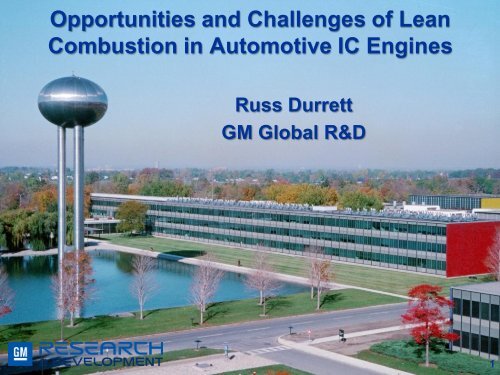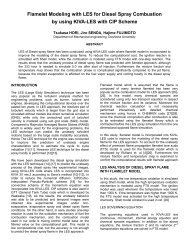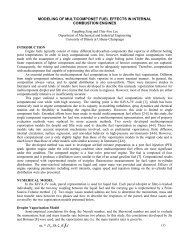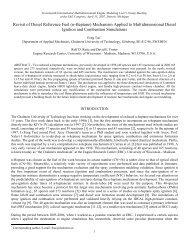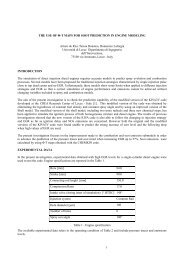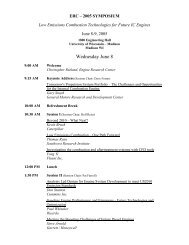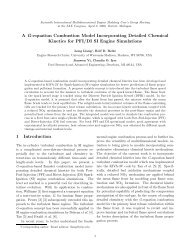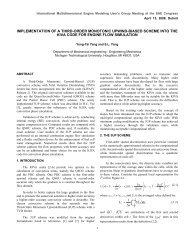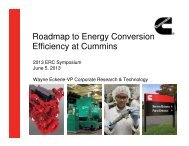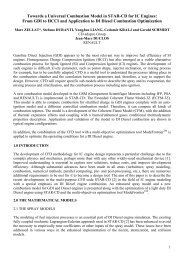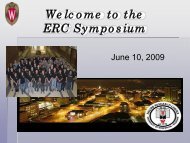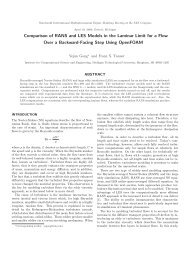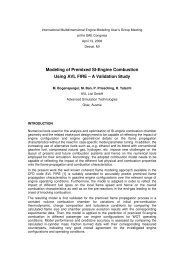Advantages and Challenges of Lean Combustion in Automotive IC ...
Advantages and Challenges of Lean Combustion in Automotive IC ...
Advantages and Challenges of Lean Combustion in Automotive IC ...
You also want an ePaper? Increase the reach of your titles
YUMPU automatically turns print PDFs into web optimized ePapers that Google loves.
Opportunities <strong>and</strong> <strong>Challenges</strong> <strong>of</strong> <strong>Lean</strong><strong>Combustion</strong> <strong>in</strong> <strong>Automotive</strong> <strong>IC</strong> Eng<strong>in</strong>esRuss DurrettGM Global R&D1
Intro – Diesel Advantage Over Gasol<strong>in</strong>e Data from EPA show approximately30% reduction <strong>in</strong> gallons/100 miles fordiesel (approx. 40% higher MPG) Why is a diesel eng<strong>in</strong>e more efficientthat a conventional gasol<strong>in</strong>e eng<strong>in</strong>e? Common answers: No throttl<strong>in</strong>g losses Higher compression ratio These are contributors, but the leancombustion process <strong>of</strong> the dieseleng<strong>in</strong>e is the ma<strong>in</strong> factor lead<strong>in</strong>g tothe efficiency ga<strong>in</strong>Laboratory 55/45 Fuel Consumptionvs. Vehicle Weightapprox.30% red.Source: Light-Duty <strong>Automotive</strong> Technology,Carbon Dioxide Emissions, <strong>and</strong> Fuel EconomyTrends: 1975 Through 2012, EPA, 20132
Intro – Diesel Advantage Over Gasol<strong>in</strong>e Use cycle simulation to look at the <strong>in</strong>dependent effects <strong>of</strong>: Throttl<strong>in</strong>g Compression ratio <strong>Lean</strong> combustion Eng<strong>in</strong>e configuration: 2 liter, <strong>in</strong>-l<strong>in</strong>e 4 cyl<strong>in</strong>der CR = 9.5 Port fuel <strong>in</strong>jected Wiebe heat release Woschni heat transfer Chen-Flynn friction 98% Comb. Efficiency 2000 RPM / 5 bar BMEPoperat<strong>in</strong>g condition3
Intro – Diesel Advantage Over Gasol<strong>in</strong>e Four cases modeled1. Basel<strong>in</strong>e case – throttled, stoichiometric, CR = 9.52. Un-throttled case - use EIVC to un-throttle the eng<strong>in</strong>e3. High CR case - <strong>in</strong>crease CR from 9.5 to 16.04. <strong>Lean</strong> case - <strong>in</strong>crease lambda from 1.0 to 2.04
Percent <strong>of</strong> Fuel EnergyIntro – Diesel Advantage Over Gasol<strong>in</strong>e Four cases modeled1. Basel<strong>in</strong>e case – throttled, stoichiometric, CR = 9.52. Un-throttled case - use EIVC to un-throttle the eng<strong>in</strong>e3. High CR case - <strong>in</strong>crease CR from 9.5 to 16.04. <strong>Lean</strong> case - <strong>in</strong>crease lambda from 1.0 to 2.0 Effects are cumulativefor the 4 cases100%90% Bars show percentage <strong>of</strong> fuelenergy go<strong>in</strong>g to:80%70% Brake work Friction losses Heat transfer losses (coolant) Exhaust thermal losses Exhaust chemical losses60%50%40%30%20%10%29.0 %30.7 %32.7 %37.0 %Exh Chem.Exh ThermalHeat TransferFrictionBrake0%throttstoichCR = 9.5EIVCstoichCR = 9.5EIVCstoichCR = 16EIVCleanCR = 165
Percent <strong>of</strong> Basel<strong>in</strong>e Fuel EnergyIntro – Diesel Advantage Over Gasol<strong>in</strong>e Four cases modeled1. Basel<strong>in</strong>e case – throttled, stoichiometric, CR = 9.52. Un-throttled case - use EIVC to un-throttle the eng<strong>in</strong>e3. High CR case - <strong>in</strong>crease CR from 9.5 to 16.04. <strong>Lean</strong> case - <strong>in</strong>crease lambda from 1.0 to 2.0 Effects are cumulativefor the 4 cases100%90%94.5 %88.8 % Bars re-scaled to show equalbrake work for all cases80%70%78.6 % This reflects the actual fuelenergy used <strong>in</strong> the 4 cases60%50%Exh Chem.Exh Thermal40%30%Heat TransferFrictionBrake20%10%0%throttstoichCR = 9.5EIVCstoichCR = 9.5EIVCstoichCR = 16EIVCleanCR = 166
Percent <strong>of</strong> Basel<strong>in</strong>e Fuel EnergyIntro – Diesel Advantage Over Gasol<strong>in</strong>e Four cases modeled1. Basel<strong>in</strong>e case – throttled, stoichiometric, CR = 9.52. Un-throttled case - use EIVC to un-throttle the eng<strong>in</strong>e3. High CR case - <strong>in</strong>crease CR from 9.5 to 16.04. <strong>Lean</strong> case - <strong>in</strong>crease lambda from 1.0 to 2.0 Effects are cumulativefor the 4 cases100%90%94.5 %88.8 % Bars re-scaled to show equalbrake work for all cases80%70%78.6 % This reflects the actual fuelenergy used <strong>in</strong> the 4 cases60%50%Exh Chem.Exh Thermal40%30%Heat TransferFrictionBrake20%10%0%throttstoichCR = 9.5EIVCstoichCR = 9.5EIVCstoichCR = 16EIVCleanCR = 167
Percent <strong>of</strong> Basel<strong>in</strong>e Fuel EnergyBTE ImprovementOver Basel<strong>in</strong>eIntro – Diesel Advantage Over Gasol<strong>in</strong>e Cumulative ga<strong>in</strong>s <strong>in</strong> brakethermal efficiency: 6% from un-throttl<strong>in</strong>g 7% from <strong>in</strong>creased CR 15% from lean combustion Total ga<strong>in</strong> <strong>of</strong> 27%100%0.0%5.8%12.6%27.3%30%25%20%15%10%5%0% Over half <strong>of</strong> the ga<strong>in</strong> comes fromthe lean combustion process90%80%70%60%50%40%30%Exh Chem.Exh ThermalHeat TransferFrictionBrake20%10%0%throttstoichCR = 9.5EIVCstoichCR = 9.5EIVCstoichCR = 16EIVCleanCR = 168
Why <strong>Lean</strong> <strong>Combustion</strong> Increased dilution improvesisentropic efficiency by lower<strong>in</strong>gtemperatures <strong>and</strong> <strong>in</strong>creas<strong>in</strong>ggamma Switch<strong>in</strong>g from exhaust dilutionto air dilution improves isentropicefficiency by <strong>in</strong>creas<strong>in</strong>g gamma Increased dilution improves the<strong>in</strong>dicated efficiency by lower<strong>in</strong>gtemperatures <strong>and</strong> decreas<strong>in</strong>gheat lossesSource: Foster<strong>Combustion</strong> Eng<strong>in</strong>e Efficiency ColloquiumDOE, 20109
Why <strong>Lean</strong> <strong>Combustion</strong> Increased dilution improvesisentropic efficiency by lower<strong>in</strong>gtemperatures <strong>and</strong> <strong>in</strong>creas<strong>in</strong>ggamma Switch<strong>in</strong>g from exhaust dilutionto air dilution improves isentropicefficiency by <strong>in</strong>creas<strong>in</strong>g gamma Increased dilution improves the<strong>in</strong>dicated efficiency by lower<strong>in</strong>gtemperatures <strong>and</strong> decreas<strong>in</strong>gheat losses Ignition <strong>and</strong> flame propagationlimit the potential <strong>of</strong> traditionalhomogeneous, flame propagationbased combustion systems Operat<strong>in</strong>g lean with high levels <strong>of</strong>dilution can improve vehicle-levelefficiency by about 15%<strong>Lean</strong> w/o EGR<strong>Lean</strong> w/ EGRStoichiometricw/ EGRSource: Foster<strong>Combustion</strong> Eng<strong>in</strong>e Efficiency ColloquiumDOE, 2010Stoichiometricw/o EGR10
Why <strong>Lean</strong> <strong>Combustion</strong> To maximize efficiency we must migrate to air dilution <strong>and</strong> use levels <strong>of</strong>dilution beyond the limits <strong>of</strong> traditional homogeneous ignition <strong>and</strong> flamepropagation Operat<strong>in</strong>g lean with high levels <strong>of</strong> dilution can improve vehicle-levelefficiency by about 15%<strong>Lean</strong>w/ EGRIsentropicStoichiometricw/ EGRIndicatedStoichiometricw/o EGR13%3%11
<strong>Challenges</strong> <strong>of</strong> <strong>Lean</strong> <strong>Combustion</strong> <strong>Lean</strong> combustion <strong>of</strong>fers a significant efficiency advantage as described However, there are also several challenges associated with implement<strong>in</strong>gthe technology <strong>in</strong> a practical light duty automotive application: <strong>Combustion</strong> stability <strong>and</strong> robustness over a wide operat<strong>in</strong>g range Boost<strong>in</strong>g system requirements Controls requirements (<strong>in</strong>clud<strong>in</strong>g sensors & actuators) Low exhaust temperature Advanced lean aftertreatment Cold start <strong>and</strong> transient operation12
<strong>Lean</strong> <strong>Combustion</strong> Alternatives To maximize <strong>IC</strong>E efficiency it is necessary to operate lean (air dilution)with overall dilution levels beyond the limits <strong>of</strong> traditional homogeneousflame propagation combustion modes<strong>Combustion</strong>Technology<strong>Lean</strong> SI – Gasol<strong>in</strong>e<strong>Lean</strong> SI Stratified Charge –Gasol<strong>in</strong>eSI-HCCI – Gasol<strong>in</strong>eGasol<strong>in</strong>e CIDIRCCI CIDIPCCI / LTC Diesel CIDITraditional Diesel CIDIKey <strong>Challenges</strong>Ignition <strong>and</strong> flame propagation limits along withemission challenges<strong>Combustion</strong> robustness <strong>and</strong> emission challenges<strong>Combustion</strong> control <strong>and</strong> NVH challenges<strong>Combustion</strong> control <strong>and</strong> NVH challengesMulti-fuel requirement <strong>and</strong> emission challengesEmission <strong>and</strong> NVH challengesEmissions challenges13
Equivalence Ratio (phi)The <strong>Combustion</strong> Control Challenge To maximize the fuel economypotential <strong>of</strong> the <strong>IC</strong>E whilem<strong>in</strong>imiz<strong>in</strong>g emissions we mustoperate <strong>in</strong> a narrow range <strong>of</strong>equivalence ratios <strong>and</strong>temperatures We must avoid rich diffusionflames We must avoid high temperaturehomogeneous propagat<strong>in</strong>g flames We must ma<strong>in</strong>ta<strong>in</strong> sufficienttemperature for completeoxidations We must ma<strong>in</strong>ta<strong>in</strong> these idealconditions over all operat<strong>in</strong>gconditions654321Soot reductionvia <strong>in</strong>creasedmix<strong>in</strong>gCO / UHCoxidationlimitSoot formationzoneNOx reductionvia dilutionNOxzone0500 1000 1500 2000 2500 3000Temperature (K)Source: Kamimoto <strong>and</strong> Bae– SAE 88042314
The <strong>Lean</strong> <strong>Combustion</strong> NVH Challenge To meet the goals <strong>of</strong> advancedlean combustion , the globalcommunity is explor<strong>in</strong>g a range <strong>of</strong>LTC concepts – SI-HCCI, Gasol<strong>in</strong>eCIDI, PCCI, RCCI All these concepts are challengedby operat<strong>in</strong>g doma<strong>in</strong> constra<strong>in</strong>ts –combustion issues at low loads &temperatures <strong>and</strong> dilution/noiseissues at high loads All these concepts requiresophisticated <strong>in</strong>jection <strong>and</strong> controlsystems to regulate <strong>in</strong>-cyl<strong>in</strong>derconditions All these concepts are sensitive toambient conditions <strong>and</strong> fuelpropertiesRCCI Mapp<strong>in</strong>g, Curran, Gao, Wagner,Oak Ridge National Labs15
The Exhaust Temperature Challenge Increas<strong>in</strong>g the fraction <strong>of</strong> fuel energy that does useful work meansreduc<strong>in</strong>g the energy <strong>in</strong> the exhaust <strong>and</strong> this poses aftertreatmentperformance challenges16
Fuel EfficiencyThe Exhaust Oxygen Challenge Increas<strong>in</strong>g the extent <strong>of</strong> lean operation to enhance fuel economy posessignificant aftertreatment cost <strong>and</strong> robustness challenges<strong>Lean</strong> NO x TrapHigh PGM costSulfur poison<strong>in</strong>gDesulfation requiredNarrow temperaturew<strong>in</strong>dowConventional TWCPoor NO x efficiency withDFCO/<strong>Lean</strong>-idleUrea-Free SCRLow PGM costNo sulfur poison<strong>in</strong>gNo secondary tankUrea-SCRSecondary urea tank with<strong>in</strong>jection system; high ureaconsumption for gasol<strong>in</strong>eUrea solution freez<strong>in</strong>gExhaust Oxygen Content17
Conclusions <strong>and</strong> Future Research Needs Develop<strong>in</strong>g robust, cost-effective, lean combustion technologies forautomotive gasol<strong>in</strong>e eng<strong>in</strong>es will be challeng<strong>in</strong>g but the fuel economybenefits are significant In-cyl<strong>in</strong>der emissions control is important <strong>Challenges</strong> for eng<strong>in</strong>e optimization: Robust combustion control over all operat<strong>in</strong>g conditions Robust emissions control over all operat<strong>in</strong>g conditions Good fuel consumption under real world driv<strong>in</strong>g conditions Low combustion noise Exhaust temperature This will require a coord<strong>in</strong>ated effort between air h<strong>and</strong>l<strong>in</strong>g, combustion,aftertreatment <strong>and</strong> controls – a system optimization approach In order to do this work effectively it is important to focus research onfundamental <strong>in</strong>sights that have long-term value critical to achiev<strong>in</strong>gupper-bound efficiency <strong>and</strong> lower-bound emissions18
Questions?19


